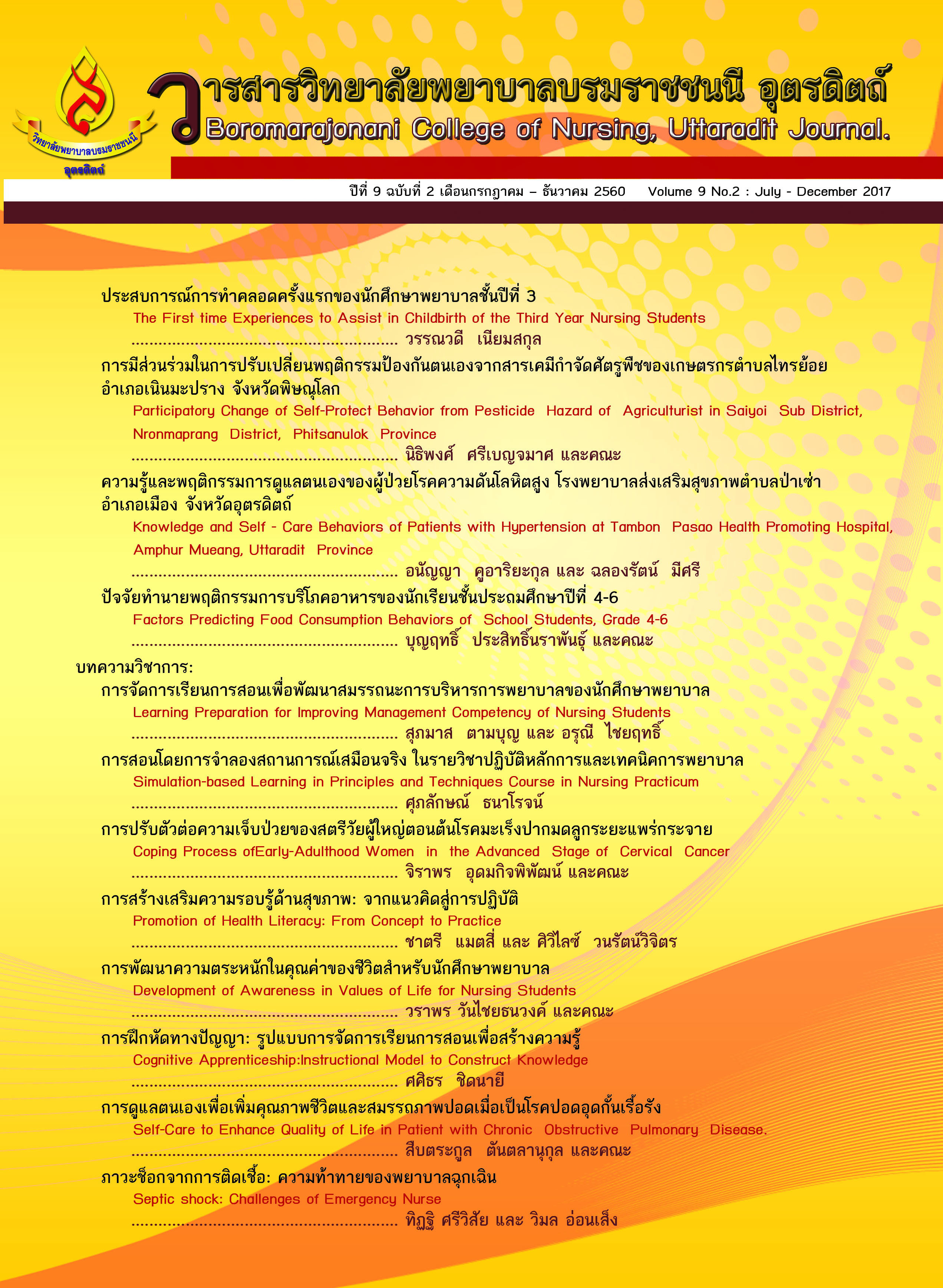การปรับตัวต่อความเจ็บป่วยของสตรีวัยผู้ใหญ่ตอนต้นโรคมะเร็งปากมดลูกระยะแพร่กระจาย
Main Article Content
บทคัดย่อ
The advanced stage of cervical cancer is recognized as a life threatening to early-adulthood
women who start to secure their life prosperity and prepare for their maternal role adaptation. When a
woman is diagnosed with advanced-stage cervical cancer, it can immensely affect the psychological
well-being of the women. She may deny, have fear, be depressed, feel lost, and hopeless. Helping the
patients to have an good coping process is important. The coping can be divided into 3 stages, based on
the stimuli, as follows: The coping process divides into 3 stages as follows. 1) The pre-diagnostic stage:
the patients seek the cervical cancer examination, when the signs and symptoms of cervical cancer are
severe manifestations such as hypermenorrhea. Therefore, it leads to a delay diagnosis. In this stage,
the patients have a hope that they can be cured and come back to normal life.2) The diagnostic
confirmation stage: in this stage the tissue biopsy was identified as well as computer tomography and
hysteroscopy will be done to confirm the diagnosis. The chemotherapy or radiation will be given to the
patients. In case patients have a good adaptation, they will have positive behaviors or “adaptive
response” that can make the patients have a strength, have a hope, and cooperate in medical care and
treatment. They have a hope that the cancer cells will respond to the treatment well and they can live
longer. 3) Acceptance stage: the patients have poor responses to the treatment. A metastasis can be
found in other organs and their health condition gets worse. They will adapt themselves to the
condition, accept it, and be prepared for a good death.
Article Details
บทความหรือข้อคิดเห็นใดใดที่ปรากฏในวารสารวิจัยการพยาบาลและวิทยาศาสตร์สุขภาพ เป็นวรรณกรรมของผู้เขียน ซึ่งบรรณาธิการหรือสมาคมศิษย์เก่า ไม่จำเป็นต้องเห็นด้วย และบทความที่ได้รับการตีพิมพ์เผยแพร่ถือเป็นลิขสิทธิ์ของวารสารวิจัยการพยาบาลและวิทยาศาสตร์สุขภาพ
References
2. Chandel, S.S., Singh, K.K, Nigam, A.K. & Baghel, R.S.(2013).Role of twice weekly HDR-brachytherapy in management of carcinoma of uterine cervix-experience of Rural centre in India. Global Journals Inc.
3. Cuzick, J., Arbyn, M., Sankaranarayanan, R., Tsu, V., Ronco, G., Mayr and MH et al. (2008). Overview of human papillomavirus - basedand other novel options for cervical cancerscreening in developed and developing countries.Vaccine 2008; 26 Suppl 10: K29-K 41.
4. Faculty of Nursing, Chulalongkorn University. (2012). Theory and Practical Approaches: Client-oriented Theories. Chulalongkorn University.
5. Ferlay, J., Shin, H.R., Bray, F., Forman, D., Mathers, C.,Parkin,. D.M,. & GLOBOCAN. (2009). Cancer incidence and Mortality Worldwide: IARC Cancer Base No.10. Lyon, France: International Agency for Research on Cancer;2010. Available at: http://globocan.iarc.fc.
6. Fitzmaurince, C., Dicker, D., Pain, A., Hamavid, H., Moradi-Lakeh, M., et al.(2015) The Global Burden of Cancer 2013. JAMA Oncol; 1 (4): 505-27.
7.ื Garland, S.M. & Smith, J.S.(2010) Humanpapilloma visrus vaccines : current status and future prospects. Drugs 2010 ;70 1079-98.
8. Han, J.J., &Kohn, E.c. (2010).The NewFIGO Stagingfor Carcinomaof thevulva, cervix, endometrium, and sacromas, Retrieved, from McGraw-Hill 2010 Website. Available at:http://www.medscape.com/viewarticle/722721.
9. Hacker, N.F.,Friedlander, M.L., Cervical Cancer, in: Berek,J.S., Hacker berek, N.F., editors.Berek& Hacker’s.(2010) gynecologic oncology. Williams & Willings;201010000K341-341 -95.
10. Khuhaprema,T.,Srivatanakul,P. ,Attasara, P.,Attasara, P., Sriplung, H., Wiangnon, S.,Sumisawan, Y., editors. (2010). Cancer in Thailand Volume.V,2001-2003. Bangkok : Bangkok Medical Publisher;2010.
11. Maneerat, J.( 2009). IsPapsmear appropriate for confirmation in VIA positive women before having colposcopy Srinagarind Med J 2009;24:326-31
12. Pecorelli, S., Zigliani, L., Odicino, F. (n.d.) Revised FIGO staging for carcinoma of the cervix Int J GynecolObstet 2009; 105: 107-108.
13. Poomphun, W. (2016). How to face grief and loss. Department of Mental Health and Psychiatric Nursing. Retrieved 15 March, 2017: from http://www.ns.mahidol.ac.th/english/th/ns_academic/56/01/sad_th.html
14. Roy, C.,& Andrews, H. A., (1999). The Roy adaptation model. California: Appleton & Lange.
15. Sangmanee, S., Apanuntikul, M., & Sirapornngang, Y. (2012). Case study: adaptation of relatives and caregivers of patients with strokes, who are working outside from home. Rama Nursing Journal, 18 (1), 119-133.
16. Sirilerttrakul, S.et al. (2012). Nursing Care for Patients with Cancer: 1st edition. Sintaweekit Printing Limited.
17. Srisomboon, J. (2014). Cervical Cancer Diagnosis and Treatment. P.B. Foreign Book Center: Bangkok
18. Srisomboon, J. &Kiatprakul, C. (2011).Cancer of the Gynecology. Bangkok Printing Co., Ltd. Sriplung,H., Singkham, P., Lamsririthawom, S., Jiraphongsa, C. & Bilheem, S.(2014). Success of a cervical cancer screening program :trends in incidence in Songkhla, Southern Thailand. 1989-2010, and prediction of future incidences to 2030.Asian Pac J Cancer prev 2014;15(22):1003-8.
19. World Health Organization.(2013).Cancer.(Online). http://www.who.int/mediacentre/factsheets/fs297/en/index.html, January 25, 2013.

